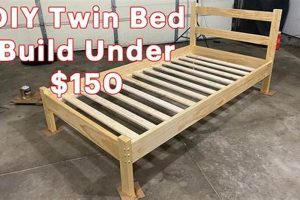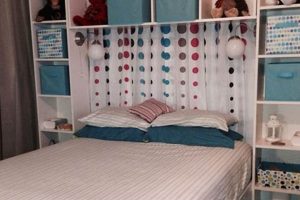A television concealed within a decorative picture frame represents a blend of technology and interior design. This involves modifying a standard television and integrating it into a custom-built or repurposed picture frame, effectively disguising the screen when not in use. The creation process commonly includes crafting a frame, mounting the television securely, and potentially incorporating a hinged or sliding mechanism to reveal the screen as needed.
This integration of technology and art offers several advantages, most notably the minimization of visual clutter in living spaces. The presence of a prominent black screen can be aesthetically disruptive; concealing it behind artwork or a decorative frame helps maintain a more harmonious and curated interior. Historically, concealing technology within furniture or decorative elements has been a recurring theme in design, reflecting a desire to integrate functionality seamlessly into living environments.
The following sections will explore the components involved in creating such a system, the tools and skills required for construction, and considerations for optimizing both the aesthetic appeal and the functional performance of the resulting display.
Tips for Constructing a Concealed Television Display
The construction of a concealed television display requires careful planning and execution to achieve a seamless integration of technology and aesthetics. Consider the following guidelines to ensure optimal results.
Tip 1: Frame Selection and Dimensions: Prioritize selecting a frame material that complements the existing dcor. Precise measurements of the television screen are crucial for determining the internal dimensions of the frame. Account for a slight recess to accommodate any mounting hardware and ensure proper ventilation.
Tip 2: Hinge Mechanism and Access: The chosen hinge mechanism should be robust and capable of supporting the weight of the frame. Adequate access to the television’s ports and controls must be incorporated into the design. Consider a removable back panel for ease of maintenance and adjustments.
Tip 3: Ventilation and Heat Dissipation: Television screens generate heat. Strategically positioned ventilation openings, discreetly integrated into the frame’s design, are essential to prevent overheating and potential damage to the television components. Thermal management is paramount for long-term reliability.
Tip 4: Cable Management and Concealment: Implement a clean and organized cable management system. Utilize concealed channels within the frame to route power and signal cables. Avoid cable clutter to maintain a visually appealing and professional finish.
Tip 5: Mounting Hardware and Security: Employ secure mounting hardware suitable for the weight and dimensions of the television. Ensure the frame is securely attached to the wall to prevent accidental falls. Safety is a primary concern throughout the construction process.
Tip 6: Acoustic Considerations: When the television is concealed, audio quality can be impacted. Consider integrating a soundbar or external speakers into the design. Acoustic fabric or strategically placed openings can improve sound transmission.
Tip 7: Art Integration and Display: The artwork or decorative element chosen to conceal the television should be carefully selected to complement the room’s aesthetic. Consider using a stretched canvas or a framed print that can be easily removed or hinged to reveal the screen.
By carefully considering these tips, individuals can successfully create a concealed television display that enhances the aesthetic appeal of their living space while maintaining the functionality of a modern entertainment system. Attention to detail, precision in construction, and a focus on safety are crucial for achieving a professional and lasting result.
The following section will present a step-by-step guide for the implementation of the aforementioned tips.
1. Frame aesthetics
Frame aesthetics constitute a foundational element in the successful realization of a “diy picture frame tv.” The chosen frame directly influences the perceived integration of the television screen into the surrounding environment. A poorly chosen or executed frame detracts from the desired effect, rendering the concealed television an incongruous element within the room. Conversely, a frame that complements the existing décor allows the television to seamlessly blend into the background when not in use. The causal relationship is direct: considered aesthetic choices yield visual harmony, while disregard for aesthetics results in visual discord. A classic example involves matching the frame’s wood finish to existing furniture, thereby creating a cohesive design.
The importance of frame aesthetics extends beyond mere visual appeal. A carefully selected frame can elevate the perceived value of the installation, transforming a functional object into a decorative art piece. For instance, a “diy picture frame tv” constructed with a repurposed antique frame acquires a unique character and adds an element of historical interest to the room. The practical significance of understanding this connection lies in the ability to tailor the “diy picture frame tv” to individual aesthetic preferences and interior design schemes, resulting in a personalized and visually appealing entertainment solution. The decision to use a minimalist black frame versus an ornate gilded frame will drastically change the final appearance.
In summary, frame aesthetics are paramount to the overall success of a “diy picture frame tv.” Attention to detail in frame selection and construction directly impacts the visual integration and aesthetic appeal of the finished product. While technical considerations such as hinge mechanisms and ventilation are crucial for functionality, the frame is the primary visual interface between technology and décor, making it a critical component in achieving the desired concealment and aesthetic harmony. Challenges may arise in sourcing frames that perfectly match existing décor or require custom fabrication, however, the effort spent in this area yields substantial aesthetic benefits.
2. Hinge Mechanism
The hinge mechanism serves as a critical functional component in the design and implementation of a “diy picture frame tv.” It dictates the method by which the decorative frame, concealing the television screen, is opened and closed, influencing both the accessibility of the display and the overall aesthetic integration of the unit.
- Load-Bearing Capacity
The hinge mechanism must possess sufficient load-bearing capacity to support the weight of the frame and any attached artwork. Failure to adequately account for the frame’s mass can result in hinge failure, leading to operational difficulties and potential damage. Examples include heavy wooden frames requiring robust steel hinges versus lighter canvas frames that can utilize simpler, less substantial hardware. Insufficient capacity is a frequent cause of malfunction.
- Range of Motion and Clearance
The range of motion provided by the hinge mechanism directly impacts the accessibility of the television screen. A limited range of motion can obstruct the viewing angle, while excessive motion may compromise the structural integrity of the frame. Furthermore, adequate clearance must be ensured to prevent the frame from contacting the wall or surrounding surfaces during operation. A 180-degree hinge allows the frame to lay flat against the wall, maximizing viewing angles; a less capable hinge might require angled viewing or even limit visibility.
- Durability and Longevity
The chosen hinge mechanism should exhibit durability and longevity to withstand repeated opening and closing cycles. Lower-quality hinges are prone to wear and tear, resulting in operational instability and eventual failure. Regular use places significant stress on the hinges, necessitating robust construction from durable materials. The operational life of the mechanism directly affects the perceived value and lifespan of the “diy picture frame tv.”
- Aesthetic Integration
The hinge mechanism should be aesthetically integrated into the design of the “diy picture frame tv.” Exposed hinges can detract from the overall visual appeal, while concealed hinges contribute to a cleaner, more professional aesthetic. The type of hinge (e.g., concealed, butt, piano) dictates the visible presence and stylistic compatibility with the chosen frame. Hidden hinges may necessitate more complex installation; however, the resulting clean appearance is often preferred.
The selection and implementation of an appropriate hinge mechanism represent a crucial design consideration in the creation of a functional and aesthetically pleasing “diy picture frame tv.” The characteristics of the chosen mechanism directly impact the usability, durability, and visual integration of the concealed display.
3. Ventilation Strategy
An effective ventilation strategy is a non-negotiable component of any “diy picture frame tv” project. The enclosed nature of the frame, by design, restricts airflow around the television, leading to a build-up of heat generated by the electronic components. This heat accumulation can negatively impact the television’s performance, reduce its lifespan, and, in extreme cases, pose a fire hazard. The correlation between insufficient ventilation and equipment failure is well-documented in electronics. Without proper ventilation, components such as the power supply, backlight, and processing units are subjected to elevated temperatures, accelerating degradation. This effect is particularly pronounced in modern slim-profile televisions, where components are packed tightly together.
Implementation of a suitable ventilation strategy may involve several approaches. Passive ventilation relies on strategically placed openings or vents within the frame to allow for natural convection. The size and location of these vents must be carefully calculated to ensure adequate airflow without compromising the aesthetic concealment. Active ventilation employs fans to force air circulation, providing a more effective cooling solution, especially in high-heat scenarios. The selection of fans should prioritize low noise operation to minimize audible distractions. Examples include the use of small, quiet computer case fans strategically placed to draw cool air in from the bottom of the frame and expel warm air from the top. Another example is the use of a perforated back panel, covered with speaker cloth to allow for airflow while maintaining a visual barrier. These design choices must be integrated with the frame’s structural integrity and mounting mechanism.
In summary, a well-designed ventilation strategy is paramount to the longevity and safe operation of a “diy picture frame tv.” Neglecting this aspect can lead to costly repairs or even catastrophic failure. The practical significance lies in understanding that even a beautifully crafted frame is ultimately rendered useless if it compromises the functionality of the television it is designed to conceal. Challenges may arise in balancing aesthetic considerations with the practical requirements of airflow, but prioritizing thermal management is essential. Furthermore, future advancements in display technology, such as more energy-efficient screens, may reduce the need for extensive ventilation, but even these advancements cannot eliminate the need for a considered approach to heat management in an enclosed environment.
4. Cable Concealment
Cable concealment is an integral consideration in the design and execution of a “diy picture frame tv.” The visual clutter created by dangling or exposed cables detracts significantly from the aesthetic goals of concealing the television within a decorative frame. Effective cable management is therefore essential to achieving a clean and professional finish.
- In-Wall Cable Routing
One method of cable concealment involves routing cables within the wall cavity behind the “diy picture frame tv.” This approach requires careful planning and execution, including adherence to local building codes and safety regulations. The installation of in-wall rated cables and appropriate wall plates ensures a safe and aesthetically pleasing solution. Examples include using conduit to protect the cables and prevent damage or employing recessed outlets to minimize cable protrusion.
- Cable Management Channels
Cable management channels provide an alternative to in-wall routing, offering a surface-mounted solution for concealing cables. These channels are typically made of plastic or metal and can be painted to match the wall color, minimizing their visual impact. They offer flexibility in cable routing and are easily accessible for future modifications. Examples include using adhesive-backed channels that can be attached directly to the wall or employing raceways that snap open and closed for easy cable access.
- Cord Concealers and Sleeves
Cord concealers and sleeves offer a more discreet solution for managing cables that are not suitable for in-wall routing or cable management channels. These products are designed to bundle cables together and conceal them behind furniture or along baseboards. They come in a variety of materials and colors to blend with the surrounding environment. Examples include using fabric sleeves to wrap multiple cables into a single bundle or employing cord clips to secure cables along the edge of a desk or wall.
- False Back Panels and Compartments
The design of the “diy picture frame tv” itself can incorporate false back panels or compartments to conceal cables and electronic components. This approach requires careful planning during the construction phase but can result in a seamless and highly integrated solution. Examples include creating a recessed compartment behind the television to house power supplies and cable boxes or designing a false back panel with integrated cable routing channels. The design must also consider ventilation requirements to prevent overheating.
The effective implementation of cable concealment techniques is crucial to the overall success of a “diy picture frame tv.” By minimizing visual clutter and creating a clean aesthetic, cable management enhances the integration of the television into the surrounding environment. The choice of cable concealment method depends on factors such as the existing infrastructure, the complexity of the cable routing, and the desired aesthetic outcome.
5. Mounting Security
Mounting security represents a paramount consideration in the successful implementation of a “diy picture frame tv” project. The inherent design involves concealing a significant weight within a decorative structure, thereby necessitating robust and reliable mounting solutions to prevent potential hazards and ensure long-term stability.
- Weight Distribution and Load Capacity
The mounting solution must effectively distribute the weight of the television and frame to prevent stress concentrations that could lead to failure. Consideration of the wall’s structural capacity is also crucial. Examples include using multiple mounting points across wall studs to distribute the load, or selecting mounting hardware with a load rating significantly exceeding the combined weight of the television and frame. Failure to address weight distribution can result in wall damage or, in extreme cases, catastrophic collapse.
- Mounting Hardware Selection and Compatibility
The selection of appropriate mounting hardware is directly tied to the weight, dimensions, and VESA mounting pattern of the television. Improperly sized or incompatible hardware can compromise the structural integrity of the installation. Examples include using heavy-duty wall mounts specifically designed for large, heavy televisions, or employing VESA adapters to ensure compatibility between the television’s mounting pattern and the chosen wall mount. Verification of hardware compatibility is a non-negotiable step.
- Wall Material and Anchor Selection
The type of wall material (e.g., drywall, plaster, concrete) dictates the selection of appropriate anchors to ensure a secure and stable installation. Using incorrect anchors can result in the mount pulling away from the wall, posing a significant safety risk. Examples include using toggle bolts for drywall, sleeve anchors for concrete, or lag bolts for wood studs. Understanding the properties of the wall material is essential for selecting the correct anchoring method.
- Safety Mechanisms and Redundancy
Incorporating safety mechanisms and redundancy into the mounting system can provide an additional layer of protection against potential failure. This may include using safety cables to prevent the television from falling in the event of a mount failure, or employing multiple mounting points for increased stability. Examples include securing the television to the frame with safety straps in addition to the primary mounting hardware, or using a secondary support structure to reinforce the wall mount. Redundancy enhances the overall safety and reliability of the “diy picture frame tv” installation.
The successful integration of mounting security measures is paramount to ensuring the long-term stability, safety, and aesthetic appeal of a “diy picture frame tv.” By carefully considering weight distribution, hardware compatibility, wall material, and safety mechanisms, individuals can mitigate potential risks and create a secure and visually pleasing installation. Neglecting these aspects can lead to hazardous conditions and compromise the overall value of the project.
Frequently Asked Questions
This section addresses common inquiries regarding the construction and implementation of a “diy picture frame tv,” providing concise answers to frequently raised concerns.
Question 1: What are the primary safety considerations when constructing a “diy picture frame tv”?
Electrical safety is paramount. Disconnecting power before any modifications is mandatory. Ensuring adequate ventilation to prevent overheating is crucial. Secure mounting is essential to prevent falls. Failure to observe these precautions can lead to electrical shock, fire hazards, or structural damage.
Question 2: How does one ensure adequate ventilation within the picture frame enclosure?
Ventilation can be achieved through strategically placed openings that allow for convection, or through the use of low-noise fans. The size and placement of vents depend on the heat output of the television. Monitoring temperature with a thermal sensor may be beneficial.
Question 3: What type of frame is best suited for a “diy picture frame tv” project?
Frame selection depends on aesthetic preferences and structural requirements. Solid wood frames offer durability but require robust mounting. Lighter materials such as MDF may be suitable for smaller televisions. The frame must be capable of supporting the weight of the television without warping or sagging.
Question 4: How should cables be managed to minimize visual clutter?
Cable management solutions include in-wall routing, cable channels, and cord concealers. Internal routing within the frame is also an option. Securely fastening and bundling cables prevents tangling and reduces visibility. Consider using longer cables to facilitate easier routing.
Question 5: What tools and skills are necessary for constructing a “diy picture frame tv”?
Basic woodworking skills, familiarity with electrical safety practices, and proficiency with tools such as saws, drills, and measuring devices are required. Precise measurements and careful assembly are essential for a successful outcome. Professional assistance may be considered for individuals lacking the necessary skills.
Question 6: How does the addition of a frame impact the television’s audio quality?
The frame can potentially dampen or distort the audio emanating from the television’s built-in speakers. Consider using external speakers or a soundbar to improve audio quality. Perforated frame materials or strategic placement of speaker openings can also mitigate audio interference.
In summary, constructing a “diy picture frame tv” requires careful planning, attention to detail, and adherence to safety guidelines. Addressing concerns related to ventilation, cable management, and mounting security is crucial for a successful project.
The following section explores potential challenges and troubleshooting tips associated with constructing a concealed television display.
Conclusion
The preceding examination of “diy picture frame tv” has underscored the critical elements involved in successfully integrating a television into a decorative picture frame. Factors ranging from frame aesthetics and hinge mechanisms to ventilation strategies, cable management, and mounting security are demonstrably essential for achieving a functional and visually harmonious result. Neglecting any of these aspects can compromise the longevity, safety, and overall aesthetic appeal of the concealed display.
The decision to undertake a “diy picture frame tv” project requires careful consideration of the technical skills, resources, and time commitment involved. While the potential to seamlessly blend technology with interior design is compelling, prioritizing safety and adhering to best practices remains paramount. Further advancements in display technology and design methodologies may simplify the construction process, but a foundational understanding of the principles outlined herein will continue to be invaluable for realizing a successful and enduring integration of art and entertainment.







